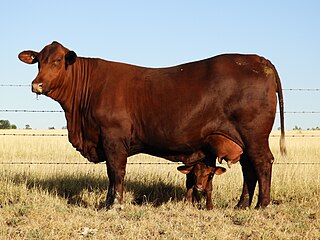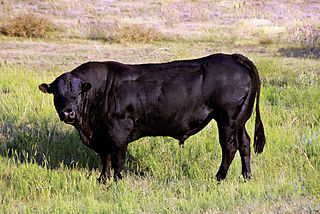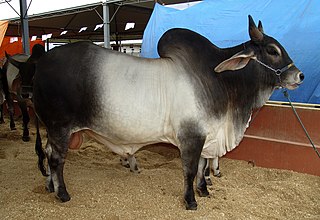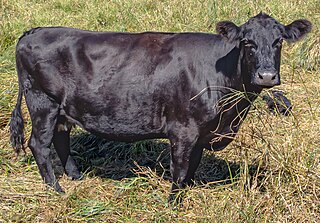
The Aberdeen Angus, sometimes simply Angus, is a Scottish breed of small beef cattle. It derives from cattle native to the counties of Aberdeen, Banff, Kincardine and Angus in north-eastern Scotland. In 2018 the breed accounted for over 17% of the beef production in the United Kingdom.

The Hereford is a British breed of beef cattle originally from Herefordshire in the West Midlands of England. It was the result of selective breeding from the mid-eighteenth century by a few families in Herefordshire, beginning some decades before the noted work of Robert Bakewell.

The Charolais or Charolaise is a French breed of taurine beef cattle. It originates in, and is named for, the Charolais area surrounding Charolles, in the Saône-et-Loire department, in the Bourgogne-Franche-Comté region of eastern France.

The Brahman is an American breed of zebuine-taurine hybrid beef cattle. It was bred in the United States from 1885 from cattle originating in India, imported at various times from the United Kingdom, India, and Brazil. These were mainly Gir, Guzerá and Nelore stock, with some Indu-Brasil, Krishna Valley and Ongole. The Brahman has a high tolerance of heat, sunlight and humidity, and good resistance to parasites. It has been exported to many countries, particularly in the tropics; in Australia it is the most numerous breed of cattle. It has been used in the creation of numerous taurine-indicine hybrids, some of which – such as the Brangus and Brahmousin – are established as separate breeds.

The Murray Grey is an Australian breed of polled beef cattle. It originated between 1905 and 1917 in the upper Murray River valley, on the border between New South Wales and Victoria. It is similar in appearance to the Aberdeen Angus, from which it largely derives, but is grey, silver or dun in colour.

The Afrikaner or Africander is an African breed of taurine-indicine cattle in the Sanga group of African cattle. It is derived from the cattle of the Khoikhoi (Hottentot) people which were already present in the area of modern South Africa when the Dutch East India Company established the Cape Colony in 1652.

The Belted Galloway is a traditional Scottish breed of beef cattle. It derives from the Galloway cattle of the Galloway region of south-western Scotland, and was established as a separate breed in 1921. It is adapted to living on the poor upland pastures and windswept moorlands of the region. The exact origin of the breed is unclear, although the white belt for which they are named, and which distinguishes the breed from black Galloway cattle, is often surmised to be the result of cross-breeding with the similarly-coloured Dutch Lakenvelder breed.

The Brangus is an American hybrid breed of beef cattle derived from cross-breeding of American Angus and Brahman stock. Registered animals have 5/8 Angus and 3/8 Brahman parentage. A similar hybrid breed, the Australian Brangus, was separately developed in Australia from about 1950.

The Limousin, French: Limousine, is a French breed of beef cattle from the Limousin and Marche regions of France. It was formerly used mainly as a draught animal, but in modern times is reared for beef. A herd-book was established in France in 1886. With the mechanisation of agriculture in the twentieth century, numbers declined. In the 1960s there were still more than 250 000 head, but the future of the breed was not clear; it was proposed that it be merged with the other blonde draught breeds of south-western France – the Blonde des Pyrénées, the Blonde de Quercy and the Garonnaise – to form the new Blonde d'Aquitaine. Instead, a breeders' association was formed; new importance was given to extensive management, to performance recording and to exports. In the twenty-first century the Limousin is the second-most numerous beef breed in France after the Charolais. It is a world breed, raised in about eighty countries round the world, many of which have breed associations.

The Santa Gertrudis is an American breed of beef cattle. It is a taurine-indicine hybrid breed, descended from both zebu and European cattle. It was bred in the early twentieth century in Texas, and received official recognition in 1940. It has been exported to many countries including Australia, Brazil and South Africa, and has contributed to the development of a number of modern breeds, among them the Barzona and the Droughtmaster.

Polled livestock are livestock without horns in species which are normally horned. The term refers to both breeds and strains that are naturally polled through selective breeding and also to naturally horned animals that have been disbudded. Natural polling occurs in cattle, yaks, water buffalo, and goats, and in these animals it affects both sexes equally; in sheep, by contrast, both sexes may be horned, both polled, or only the females polled. The history of breeding polled livestock starts about 6000 years BC.

The German Angus is a modern German breed of beef cattle. It was bred in the 1950s in West Germany by crossing Aberdeen Angus with various native German cattle breeds: the German Black Pied, the Deutsche Rotbunte and the Fleckvieh.

Australian Brangus are a polled breed of beef cattle, developed in the tropical coastal areas of Queensland, Australia by crossbreeding Brahman and Angus cattle during the 1950s.

The Australian Charbray is an Australian breed of cattle derived from a cross between the French Charolais cattle and American Brahman cattle. The charbray breed was first conceived in the United States of America in the 1930s and later introduced into Australia in 1969. In Australia, Australian charbray breeders are concentrated in the tropical Northern regions of Queensland. As of 1977, the official breeder society of Charbray cattle in Australia and New Zealand is the Charbray Society of Australia Limited, responsible for recording Charbray cattle in herd books, fostering improvement, enhancement and sales of Charbray cattle.

The Lincoln Red is a British breed of red-coated beef cattle. It originates in, and is named for, the county of Lincolnshire in the eastern Midlands of England. It was selectively bred in the late eighteenth and early nineteenth centuries by crossing large local draught cattle of the region with Teeswater Shorthorns of medium size. It was at first known as the Lincolnshire Red Shorthorn, and was a dual-purpose breed, reared both for milk and for beef. The polling gene was introduced in the early twentieth century, and the cattle are now usually polled; the word 'shorthorn' was dropped from the breed name in 1960. In the twenty-first century it is reared for beef.

North American Piedmontese cattle are a breed of domestic beef cattle originating from an imported herd of select Italian purebred Piedmontese cattle. The foundation line of breeding stock was first imported from Italy into Canada in 1979, and into the United States in the early 1980s. Piedmontese cattle are distinguished by a unique, naturally occurring gene identified as the myostatin allele mutation, or inactive myostatin gene. Myostatin prohibits muscle growth whereas an inactive gene has the opposite effect. Purebred Piedmontese are homozygous,, which means they have two identical alleles present for this unique gene. Research indicates the presence of the myostatin allele mutation produces morphological characteristics unique to the breed, such as double-muscling, beef tenderness, reduced fat content and high yield. According to the North American Piedmontese Association (NAPA), they are the first breed registry to base animal registration requirements on the presence of this specific gene which can be easily verified by DNA testing.
The Japanese Polled is a critically-endangered breed of small Japanese beef cattle. It is one of six native Japanese cattle breeds, and one of the four Japanese breeds known as wagyu, the others being the Japanese Black, the Japanese Brown and the Japanese Shorthorn. All wagyu cattle derive from cross-breeding in the early twentieth century of native Japanese cattle with imported stock, mostly from Europe. In the case of the Japanese Polled, the principal foreign influence was from the Scottish Angus breed.

The Guzerá or Guzerat is a Brazilian breed of domestic cattle. It derives from cross-breeding of Indian Kankrej cattle, imported to Brazil from 1870 onwards, with local taurine Crioulo cattle of European origin. The name is a Portuguese spelling of that of the western Indian state of Gujarat.

The Red Brangus is an American breed of hybrid beef cattle, with both taurine and indicine genetic heritage. Development began in Texas in the 1940s. It is a colour variant of the Brangus, a hybrid of American Angus and Brahman cattle, and differs from it only in colour. There are two herd-books, one international and one American. For international registration the animal must be of 5/8 Angus and 3/8 Brahman descent; in the United States, it may be any mix of the two breeds, but registration is conditional on inspection.

The American Angus is an American breed of beef cattle. It derives from the Scottish Aberdeen Angus population, but may only be black; red-coated individuals may not be registered with the American Angus Association, but can be registered as Red Angus.



















